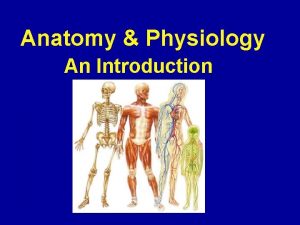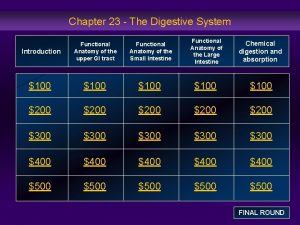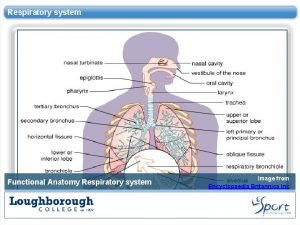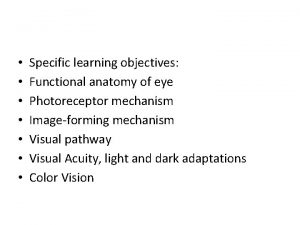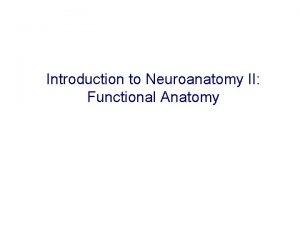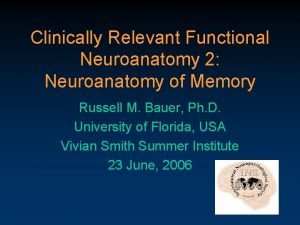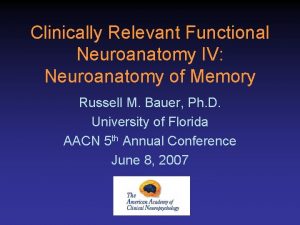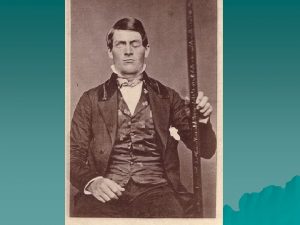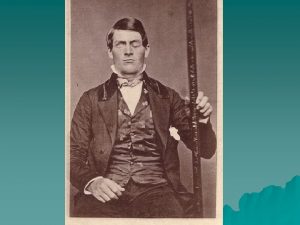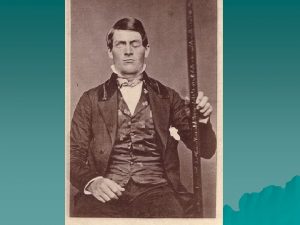Introduction to Neuroanatomy II Functional Anatomy Regional neuroanatomy












- Slides: 12

Introduction to Neuroanatomy II: Functional Anatomy

• Regional neuroanatomy: spatial relations between brain structures within a portion of the nervous system • Functional neuroanatomy: those parts of the nervous system that work together to accomplish a particular task, for example, visual perception Functional Localization

How does structure relate to function? • Heart structure predicts pumping function • Muscle structure--with particular bone attachments--predicts function • Brain? ?

Superior parietal lobule-attention Inferior frontal lobule-speech Brain functions: Determined more by how information is routed to a particular brain region than the intrinsic characteristic features of the region.

Overall Aims of Lecture • Functional localization of neural systems • Functional organization of the thalamo-cortical systems • Cortical circuitry Topics cut across all lectures • add to preparation for lab • basis for better understanding of lectures on neural systems

Specifics… • Functional localization of touch pathway in brain stem – To understand hierarchical organization of a neural system – To begin to become familiar with internal brain structure • Organization of visual pathway – Segue into… • Functional organization of the thalamo-cortical systems • Cortical circuitry

Dorsal column-medial lemniscal system for touch • • • Sensory receptor neurons Dorsal column of spinal cord Medial lemniscus in brain stem Thalamus Cortex Visual system

1° Somatic sensory cortex 1° Visual cortex Internal capsule Optic radiations from Optic tract from Medial lemniscus

Functional localization in the Thalamo-cortical systems Thalamic nucleus Touch pathway Ventral posterior nucleus Postcentral gyrus Visual pathway Lateral geniculate nucleus Occipital cortex …system… …nucleus… …cortex…

Anatomical slice through cortex: • neurons are packed into ~6 discrete layers • cortical circuit • distinct cytoarchitecture • Brodmann’s areas

Summary • Principle of functional localization • Neural pathways carry specific information – Ascending sensory; descending motor • Different thalamic nuclei serve different sensory and motor functions – More differences in inputs than intrinsic organization • Different sensory and motor functions served by different cortical areas • Structural specialization in cortex augment functional differences produced by different inputs

Brain Organization • Dual vulnerability: – Regional damage produces set of neurological (or psychiatric) impairments • Depends on location • Spinal cord injury; stroke – System damage • Must have common link for system to be a system (genetic, biochemical, early development) • Huntington’s disease; psychiatric diseases (schizophrenia); autism
 Cephalic body region
Cephalic body region The human body an orientation
The human body an orientation Regional terms anatomy
Regional terms anatomy Systemic anatomy
Systemic anatomy Transpalatal arch space maintainer indications
Transpalatal arch space maintainer indications Non functional plasma enzymes
Non functional plasma enzymes Enzymes of blood plasma
Enzymes of blood plasma Functional and non functional
Functional and non functional Functional anatomy of the digestive system
Functional anatomy of the digestive system Respiratory system
Respiratory system Functional anatomy of the eye
Functional anatomy of the eye Functional anatomy of prokaryotic and eukaryotic cells
Functional anatomy of prokaryotic and eukaryotic cells Chapter 1 introduction to human anatomy and physiology
Chapter 1 introduction to human anatomy and physiology


